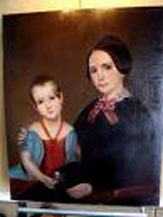

He is portrayed to the left, his eyes looking upwards to heaven. This Schutzmantelbid, or 'Virgin of Pity' painting, is also known as the Madonna of Jakob Meyer zum Hasen, shows Jakob Meyer, a Basel official, having invoked divine protection for himself and his family. Oil and tempera on lime wood - Öffentliche Kunstsammlung, Basel, Switzerland The rotting flesh can also be seen to stress the sheer miracle of the Resurrection, occurring even after the human body has decayed. Only the specific character of the wounds betray the identity of Christ." Although a fascination with the macabre was a common trait of early Protestant artists, their minds steeped in the apocalyptic horrors of the Reformation, this is not the only way in which to view Holbein's gory interpretation. Above the body, angels hold instruments of the Passion and a Latin inscription reads 'Jesus of Nazareth, King of the Jews.' Art Historian Oskar Bsatschhmann notes that "Holbein transformed the image of the Christ at rest into the dreadful vision of a corpse, that of a man who had been condemned to death. It is possible that the panel was intended as part of a Holy Tomb, in place of a sculpture or perhaps as a lid over a sepulchre.

This is an early example of Holbein's use of trompe l'oeil, a technique that he would later apply to great effect in many of his portraits. This is further enhanced by the loose strands of Christ's hair which have fallen over the edge of the surface upon which he lies and his finger which also reaches over the edge and into the viewer's plane, reinforcing the dimensionality of the space. The recess in which Christ is laid is painted with an incredible sense of depth and this adds to the realism of the piece. These elements emphasize Christ's humanity over his divine status and this is compounded by the unnaturally stretched and emaciated body being confined in an uncomfortably narrow space, imbuing it with an uneasy claustrophobia. Rather than creating a sense of calm or peace, the mouth and eyes are shown wide open, so that the pain endured on the cross seems to continue into the tomb. The greenish hue to the skin, in particular around the wounds on the hand, feet and torso, as well as on his face suggest the putrefaction of flesh and results in an almost grotesque image. In this panel, Holbein has created a life-size image of Christ, lying in his tomb. This was particularly important in a period of religious turmoil such as the Reformation.ġ521 The Body of the Dead Christ in the Tomb These were created and utilized as propaganda to convey authority, masculinity, wealth, succession, and the divine right of royalty to rule to a wider audience. Holbein's most famous images are those he painted of the English royal court and particularly of Henry VIII.With some of the meanings now lost, however, their intended messages have become an area for modern art historical debate. Many of Holbein's portraits are rich in background details, often consisting of trompe l'oeil objects such as letters, flowers, and tools and these are believed to be symbolic.Despite the meticulous nature of his portrayals, however, the images are often inscrutable, revealing little of the character of the sitter. His portraits are characterized by strong gazes, a diversity of appearance and carefully rendered clothing and accessories.

Holbein's art is considered realist in that he represented people with detail and precision, and was renowned for creating a true likeness (albeit, perhaps, a flattering one) of his sitters.


 0 kommentar(er)
0 kommentar(er)
